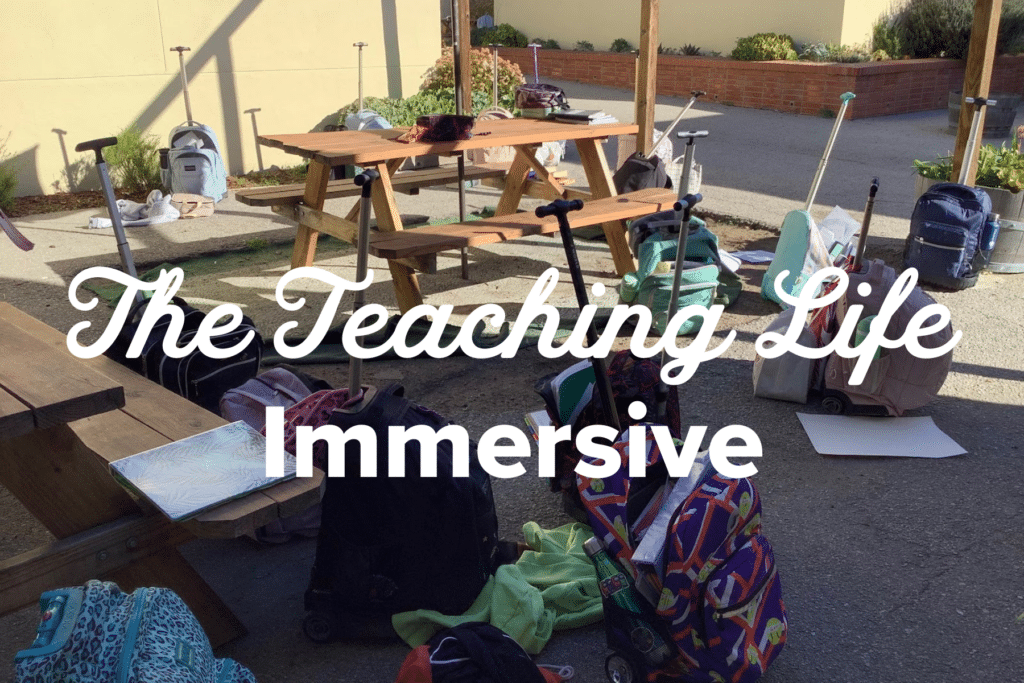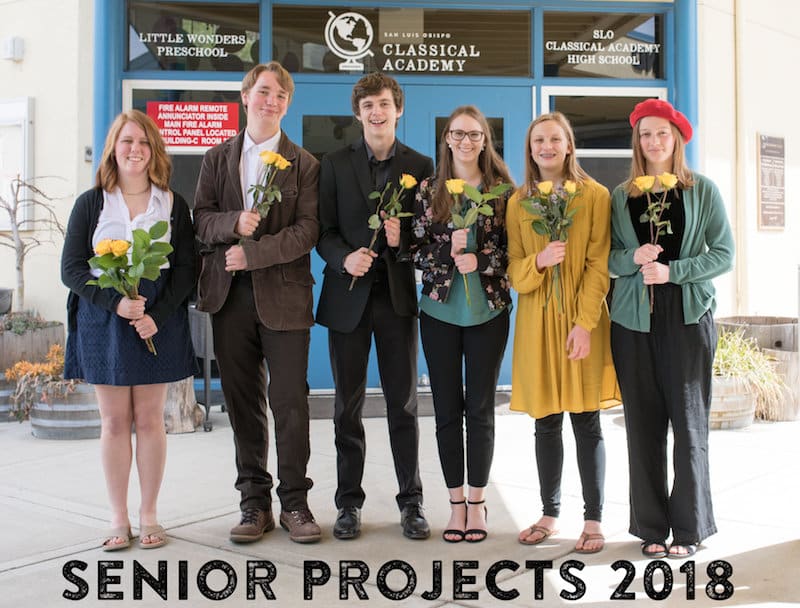
{photo by Carolyn Eicher}
We are back with our second installment of 2018 Senior Projects to share with you! If you missed last week’s blog post where we introduced this series, here’s Part 1 (and now available – Part 3). Today we will hear from two more students, who have summarized their fantastic projects for our blog readers. (Note how these two projects actually share something in common!):
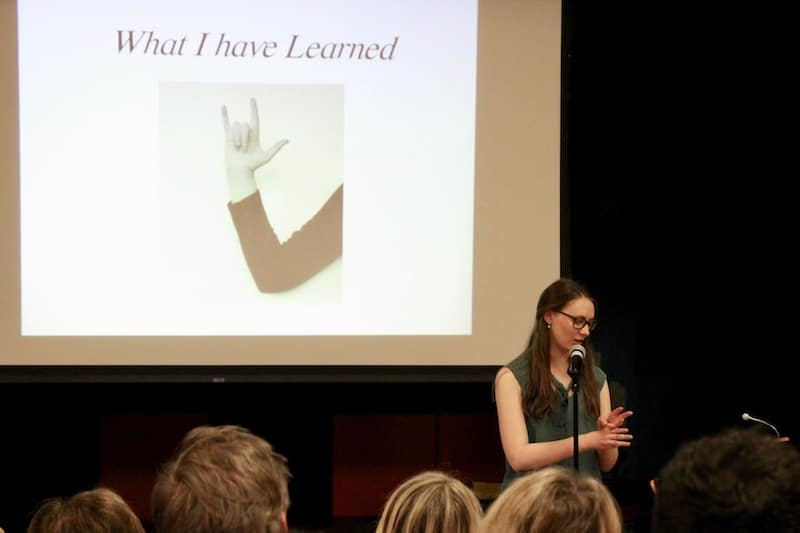 Anna Curry: Found in Translation
Anna Curry: Found in Translation
Communication, Interpretation, and the Differences between American Sign Language and Signed English
Question: What are the grammatical differences between ASL and Signed English and why are those differences important to translating?
ASL
ASL or American Sign Language was created in 1870 by Thomas Hopkins Gallaudet and Laurent Clerc and was used in their school for the deaf. ASL was used in schools until 1880 when it was banned, and oralism became the only method of communication taught. ASL was still used and preferred among the deaf at home. In 1960 there was a revival in ASL and it is now the primary way of communicating with and teaching the deaf.
The basics to any sign are:
- Hand shape: there are 18 handshapes that make up all signs
- Movement
- Palm orientation
- Location: placement of sign, but also indicates time
- Fingerspelling uses the ASL alphabet to spell out words, names, places, or things that do not have a specific sign
- Facial expression: when hearing people talk they can get across attitude through their tone. But because the deaf can not hear tones, facial expression becomes the main way to show feelings.
ASL has its own syntax and will usually follow the structure of Time + Topic + Comment. This means that the time is set, then the subject of the sentence is given, then anything concerning that subject. Sentences can just be Topic + Comment.
Signed English
Signed English was first created in 1970 after sign language was reintroduced into the classroom. The first Signed English was created by David Anthony, a deaf teacher, in response to deaf children lagging behind hearing children in reading and writing. Because of ASL’s unusual word order it was hard for deaf children to write in correct English word order.
Signed English uses all ASL signs but adds:
- Affixes such as ing, ed, and ly
- Is signed in English word order. It is signed how we talk.
- It will use articles such as: the, and, a
- Initializing
- Signed English can be broken down into two variations PSE (pidgin Signed English) which is ASL signs signed in English word order. Or SEE (Signed Exact English) which signs every word spoken, exactly how it is spoken. I focused on SEE sign because it is the complete opposite of ASL.
In SEE every word spoken in English is signed in the order that it is said along with all endings and articles.
Differences
ASL:
- Deaf preferred
- Is its own recognized language
- Has its own sentence structure
- Has multiple words per sign
SEE Sign:
- Used in classrooms
- A dialect of ASL
- Exact word order to English including affixes and articles
- Used to be clearly understood
- Slow in signing
 By diving into the differences between ASL and SEE Sign I have discovered the importance of translating. SEE Sign is direct, word for word translation of English, leaving very little room for misinterpretation, while in ASL the signs can have many meanings and nuances. When translating ASL to English, as in translating Latin to English or English into another language, the interpreter has to make many choices about how to convey the different meanings and emotions of that language. In my Latin class we lean towards translating the different pieces quite literally. Reading the same pieces of text when they have been translated by professionals I can see that the translators chose whether to keep the rhythm of the line, to keep the overall feeling or “heart,” or to use a more exact word for word translation. For me this project has helped me fully discover my interest in sign language. It also makes me take a second look at how texts are translated because there can be a lot lost, or found in translation.
By diving into the differences between ASL and SEE Sign I have discovered the importance of translating. SEE Sign is direct, word for word translation of English, leaving very little room for misinterpretation, while in ASL the signs can have many meanings and nuances. When translating ASL to English, as in translating Latin to English or English into another language, the interpreter has to make many choices about how to convey the different meanings and emotions of that language. In my Latin class we lean towards translating the different pieces quite literally. Reading the same pieces of text when they have been translated by professionals I can see that the translators chose whether to keep the rhythm of the line, to keep the overall feeling or “heart,” or to use a more exact word for word translation. For me this project has helped me fully discover my interest in sign language. It also makes me take a second look at how texts are translated because there can be a lot lost, or found in translation.
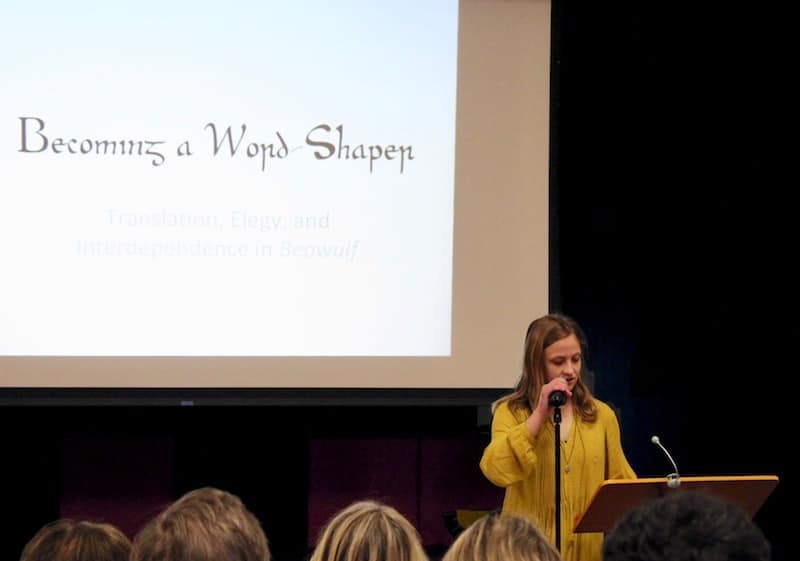 Brigitte Rein: Becoming a Word-Shaper: Translation, Elegy, and Interdependence in Beowulf
Brigitte Rein: Becoming a Word-Shaper: Translation, Elegy, and Interdependence in Beowulf
Old English poetry has shown me that words are treasures: an Anglo-Saxon bard would “unlock his word-hoard” to make a speech. This implies that words are as worthy of being hoarded as gold. Anglo-Saxons, being both incredible goldsmiths and incredible wordsmiths, had the authority to say that language is just as precious as money—and even more precious, in my opinion. Words are treasures.
For my senior project I wrote in Modern English an Old English-style elegy about Hrōðgār’s wandering the destruction of his mead-hall. I wrote this elegy to discover myself as a translator and as a word-shaper by thinking inside the voice of an Anglo-Saxon scop, a poet. This Old English word scop comes from the same root as our modern word “shape,” revealing that in Anglo-Saxon culture a poet shaped words. Similarly, my project has shaped me from a word-seeker to becoming a word-shaper myself.
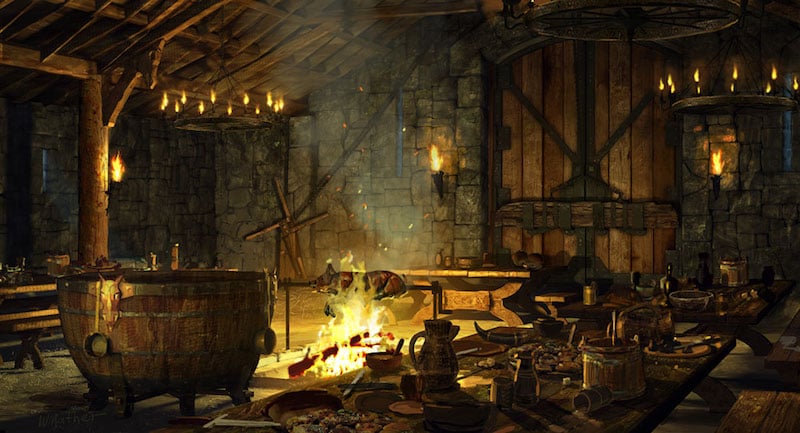
A mead hall {image source}
As my first step, I researched Old English and elegies. Old English, spoken from roughly the fifth through the twelfth centuries C.E., began with the Anglo-Saxons’ settlement in Britain and ended a little after the Norman invasion. The language was blunt and often monosyllabic, the sounds being hard and short. Anglo-Saxons told stories orally. They would gather in a mead-hall to eat and drink, listen to a poet sing stories, and stay content and warm together. Because they listened to stories aloud, the literary devices used throughout Beowulf, especially alliteration and kennings, reflect this oral tradition. Though Old English poetry does not rhyme, the sounds of the music stay alive through alliteration, rhythm, and hard consonants. Kennings, one of my favorite literary devices, are image-driven, compound word metaphors. They invoke more than just our modern definition of a word. For example, hron-rāde, means “sea,” but the kenning translates literally as whale-road. “Whale-road” far more beautifully expresses the same idea of “sea,” but it conjures images of a whole, complex ecosystem of whales and fish with their own paths and lives. Beowulf’s name is also a kenning: beo means “bee” and wulf means “hunter.” A bee-hunter, like each of us SLOCA grizzlies, is a bear. Kennings and alliteration shape the way Old English elegies were heard and understood.
Just to remind you about Beowulf: he is a monster-tearing, freedom-giving Geat hero who brings peace to the Danes and destruction to the hall-ravaging Grendel, Grendel’s mother, and a satanic dragon. Elegies abound in the story, but I focus my project on the one at the beginning, before Beowulf shows up, when Grendel is destroying Hrōðgār’s mead-hall, Heorot. An elegy is a serious, meditative poem. This poetry, though usually lamenting, often has a hopeful ending. Some themes include exile, loneliness, the passing of time, wisdom, questioning wisdom, redemption, and the hope of heaven.
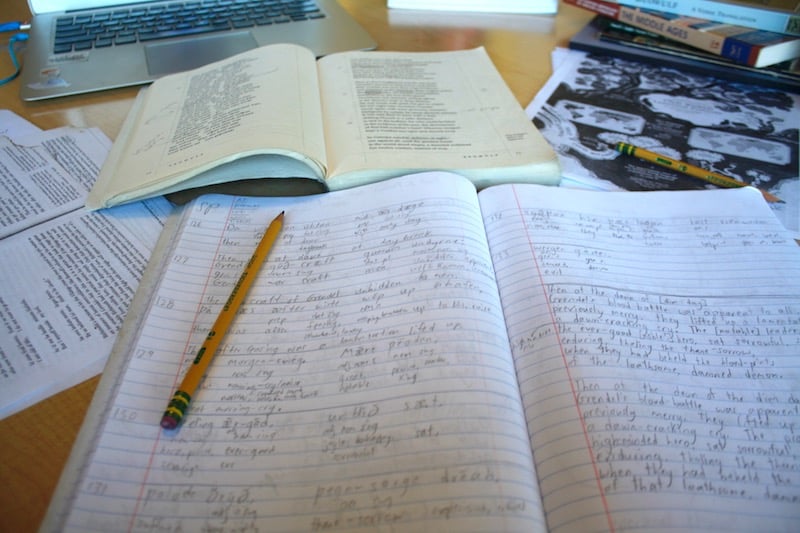 After unburying the definitions of kennings and elegies, I tried my hand at understanding Old English from within. In translating parts of Beowulf, I sought to practice thinking and writing inside the voice of an Anglo-Saxon scop; to create modern imitations of the language, feeling, and spirit of the original Old English; and to think within the language to better understand elegies from the inside. However, I discovered the tension of balancing literalness with interpretation in order to maintain faithfulness to the original text: do I choose the more accurate or the more literary word? How do I carry the weight of literary devices while keeping my translation simple enough for modern readers to understand? Should I change the original syntax to match modern grammar?
After unburying the definitions of kennings and elegies, I tried my hand at understanding Old English from within. In translating parts of Beowulf, I sought to practice thinking and writing inside the voice of an Anglo-Saxon scop; to create modern imitations of the language, feeling, and spirit of the original Old English; and to think within the language to better understand elegies from the inside. However, I discovered the tension of balancing literalness with interpretation in order to maintain faithfulness to the original text: do I choose the more accurate or the more literary word? How do I carry the weight of literary devices while keeping my translation simple enough for modern readers to understand? Should I change the original syntax to match modern grammar?
I also compared my own translations with those of Francis Barton Gummere, J.R.R. Tolkien, and Seamus Heaney because each of their distinct translations gave me better context for shaping words. Gummere—or, as I call him, the Grammar-Manager—used literal word translations, syntax, and grammar. Tolkien, the Word-Knower, left his translation of Beowulf unfinished because he kept editing without finally polishing it. However, he knows words well and proves this with his scholarly annotations, which take up about three quarters of the book you’d find in Barnes & Noble. Heaney, the Sound-Preserver, maintains the heart and sounds of the original poem with his lucid, culturally transcending translation.
Just as I gave each translator a kenning, I decided to call myself the Word-Seeker, for my project explores Old English words and elegies and is an attempt at understanding the art of word-shaping. I preferred to keep the same language as the original with exact word translations or alliterative synonyms, but change the syntax somewhat to match what makes sense to modern ears. My translations impacted my final project because dissecting the original language helped me learn the style and voice of a scop, a voice that I attempted to use myself in writing an elegy. I also modified some of my translations and put them directly into my poem because some of the specific words, kennings, and alliterative passages worked better for the elegy than those my modern mind could compose by itself.
|
The story’s interlaced structure allowed me to pluck passages from throughout Beowulf to include in my own elegiac poem—and really, this threaded structure enabled me to create my whole project of adding to the story an extra passage about Hrōðgār (usually spelled Hrothgar). Interlacing was the Anglo-Saxon art style that braided complex details together to create a beautiful whole. The language and plot of Beowulf reflect the interlaced style of Anglo-Saxon artwork because the plot progresses nonlinearly. The intertwining of structure, story, and language in Beowulf brilliantly reflects the Anglo-Saxon braided art: their lives so deeply entwined into each other’s that the art and stories they created inevitably highlight this value. Language and story line work similarly throughout Beowulf, showing the whole unity of culture, words, and people. The lines of the poem are rhythmic and alliterative, with each word dependent on the next.
 I see my own dependence in this same alliterative way because, like words, I am connected to other people relying on each other through similarities and differences to create a beautiful, balanced whole: the art of humanity. Beowulf reminds me that I too am a thread woven into the braid of human existence, interacting with, depending on, and supporting others to strengthen the greater whole. I myself am woven into Beowulf—captivated in my love of the old language, entwined by my humanness, and separated by only time. This story encourages my intellectual growth in the understanding that my life beautifully weaves into the lives of others and that this interdependence is, like Beowulf, an unresolved piece of art, forever growing and changing with the threads of human lives. Plot is not the most important aspect of Old English poetry; unity is. Because the poem balances different threads interlaced throughout the story, I am able to add a thread of my own, with the elegy I wrote about Hrōðgār. It fits directly into the poem and zooms in on Hrōðgār, pausing at the moment he falls to his knees in defeat.
I see my own dependence in this same alliterative way because, like words, I am connected to other people relying on each other through similarities and differences to create a beautiful, balanced whole: the art of humanity. Beowulf reminds me that I too am a thread woven into the braid of human existence, interacting with, depending on, and supporting others to strengthen the greater whole. I myself am woven into Beowulf—captivated in my love of the old language, entwined by my humanness, and separated by only time. This story encourages my intellectual growth in the understanding that my life beautifully weaves into the lives of others and that this interdependence is, like Beowulf, an unresolved piece of art, forever growing and changing with the threads of human lives. Plot is not the most important aspect of Old English poetry; unity is. Because the poem balances different threads interlaced throughout the story, I am able to add a thread of my own, with the elegy I wrote about Hrōðgār. It fits directly into the poem and zooms in on Hrōðgār, pausing at the moment he falls to his knees in defeat.
My poem can either stand alone or be read in context of Beowulf. To set the scene for the beginning of my elegy, Hrōðgār has finished building Heorot, his great mead-hall. And brooding Grendel, in his jealousy and anger, has been snatching away men to brutally devour them…
At the dawning of dim day,
Hrōðgār beheld Grendel’s blood-battle
and droned a dawn-cracking cry.
The praised prince, high-minded hero,
strength straining, sat sorrowful,
enduring, tholing the thane-ache. The
damned demon’s blood-prints he beheld:
footpaths, leaving through a blood-blistered
wall and littered with loosened limbs. Thus
the hell-harrower had glutted on gutted Geats,
and Hrōðgār, outlaw of his own hall,
with a heart of glazed grief
in his solitary, estranged self,
wandered the bare, bench-empty hall.
Before, on late bluster nights
with logs blazed, and hearts likewise,
goblets would pass between swigging sons,
brewing melted minds and mead murmurs
and sorry skirmishes of rash reckoning
between dear brothers, kindred companions,
who boast to brawl but band in merriment.
What great projects – thank you for sharing these, Seniors! Come back next week for our final two Senior Projects…













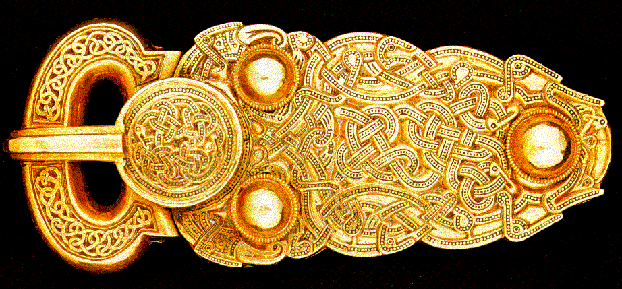 A Belt Buckle from the Sutton Hoo treasures showing the interlacing theme. {image
A Belt Buckle from the Sutton Hoo treasures showing the interlacing theme. {image 